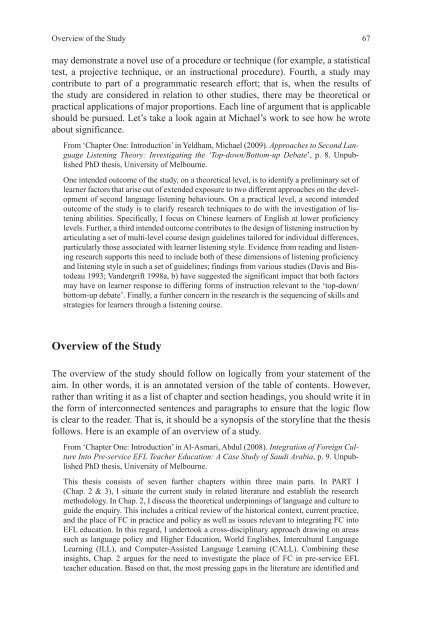How-to-Write-a-Better-Thesis
Create successful ePaper yourself
Turn your PDF publications into a flip-book with our unique Google optimized e-Paper software.
Overview of the Study<br />
67<br />
may demonstrate a novel use of a procedure or technique (for example, a statistical<br />
test, a projective technique, or an instructional procedure). Fourth, a study may<br />
contribute <strong>to</strong> part of a programmatic research effort; that is, when the results of<br />
the study are considered in relation <strong>to</strong> other studies, there may be theoretical or<br />
practical applications of major proportions. Each line of argument that is applicable<br />
should be pursued. Let’s take a look again at Michael’s work <strong>to</strong> see how he wrote<br />
about significance.<br />
From ‘Chapter One: Introduction’ in Yeldham, Michael (2009). Approaches <strong>to</strong> Second Language<br />
Listening Theory: Investigating the ‘Top-down/Bot<strong>to</strong>m-up Debate’, p. 8. Unpublished<br />
PhD thesis, University of Melbourne.<br />
One intended outcome of the study, on a theoretical level, is <strong>to</strong> identify a preliminary set of<br />
learner fac<strong>to</strong>rs that arise out of extended exposure <strong>to</strong> two different approaches on the development<br />
of second language listening behaviours. On a practical level, a second intended<br />
outcome of the study is <strong>to</strong> clarify research techniques <strong>to</strong> do with the investigation of listening<br />
abilities. Specifically, I focus on Chinese learners of English at lower proficiency<br />
levels. Further, a third intended outcome contributes <strong>to</strong> the design of listening instruction by<br />
articulating a set of multi-level course design guidelines tailored for individual differences,<br />
particularly those associated with learner listening style. Evidence from reading and listening<br />
research supports this need <strong>to</strong> include both of these dimensions of listening proficiency<br />
and listening style in such a set of guidelines; findings from various studies (Davis and Bis<strong>to</strong>deau<br />
1993; Vandergrift 1998a, b) have suggested the significant impact that both fac<strong>to</strong>rs<br />
may have on learner response <strong>to</strong> differing forms of instruction relevant <strong>to</strong> the ‘<strong>to</strong>p-down/<br />
bot<strong>to</strong>m-up debate’. Finally, a further concern in the research is the sequencing of skills and<br />
strategies for learners through a listening course.<br />
Overview of the Study<br />
The overview of the study should follow on logically from your statement of the<br />
aim. In other words, it is an annotated version of the table of contents. <strong>How</strong>ever,<br />
rather than writing it as a list of chapter and section headings, you should write it in<br />
the form of interconnected sentences and paragraphs <strong>to</strong> ensure that the logic flow<br />
is clear <strong>to</strong> the reader. That is, it should be a synopsis of the s<strong>to</strong>ryline that the thesis<br />
follows. Here is an example of an overview of a study.<br />
From ‘Chapter One: Introduction’ in Al-Asmari, Abdul (2008). Integration of Foreign Culture<br />
In<strong>to</strong> Pre-service EFL Teacher Education: A Case Study of Saudi Arabia, p. 9. Unpublished<br />
PhD thesis, University of Melbourne.<br />
This thesis consists of seven further chapters within three main parts. In PART I<br />
(Chap. 2 & 3), I situate the current study in related literature and establish the research<br />
methodology. In Chap. 2, I discuss the theoretical underpinnings of language and culture <strong>to</strong><br />
guide the enquiry. This includes a critical review of the his<strong>to</strong>rical context, current practice,<br />
and the place of FC in practice and policy as well as issues relevant <strong>to</strong> integrating FC in<strong>to</strong><br />
EFL education. In this regard, I under<strong>to</strong>ok a cross-disciplinary approach drawing on areas<br />
such as language policy and Higher Education, World Englishes, Intercultural Language<br />
Learning (ILL), and Computer-Assisted Language Learning (CALL). Combining these<br />
insights, Chap. 2 argues for the need <strong>to</strong> investigate the place of FC in pre-service EFL<br />
teacher education. Based on that, the most pressing gaps in the literature are identified and














![[Lonely Planet] Sri Lanka](https://img.yumpu.com/59845622/1/169x260/lonely-planet-sri-lanka.jpg?quality=85)


